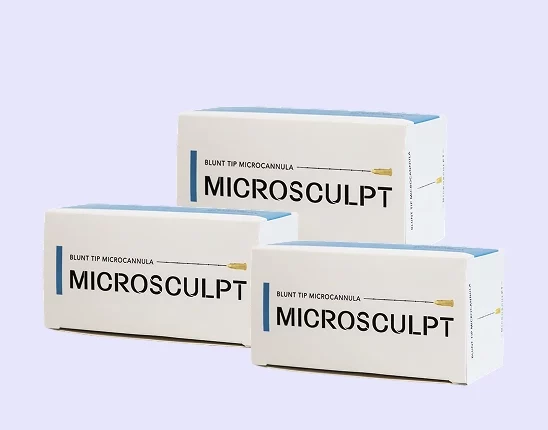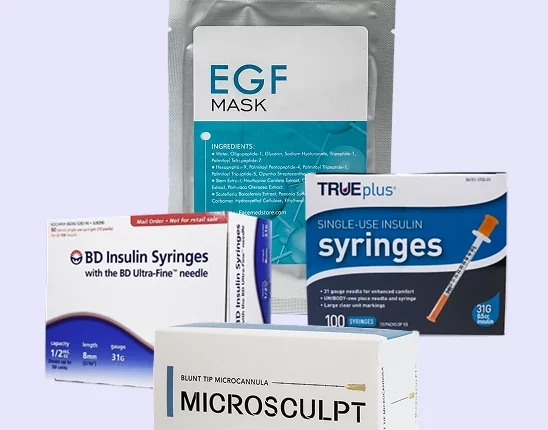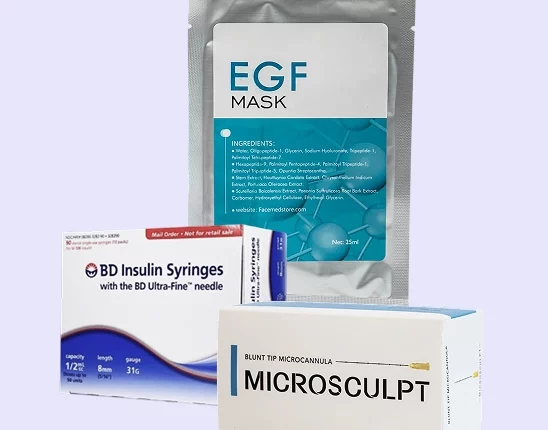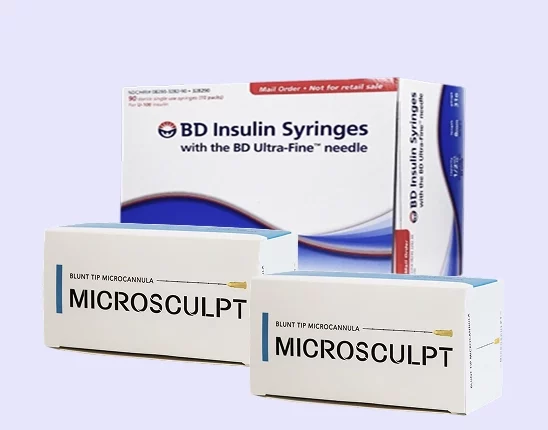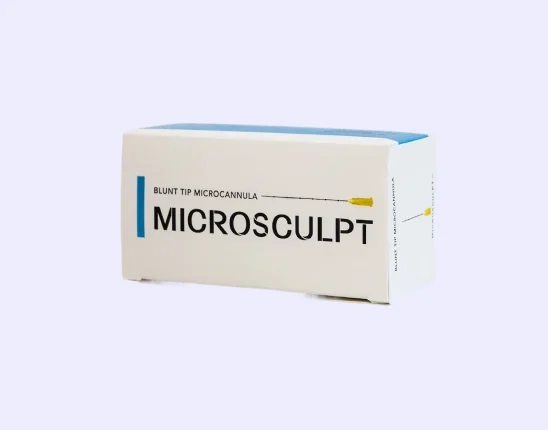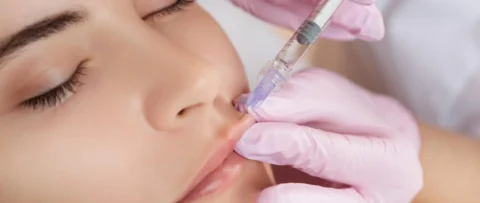Facial injectables are some of the most commonly performed cosmetic treatments today, with the vast majority of them using a filler injection to distribute facial filler around areas of the face and body. While many facial injectables like botulinum toxin products use a sharp tip needle for their treatment, there are significant advantages to using a microcannula over a traditional needle for dermal filler injection.
So how exactly should an injector use a blunt cannula for dermal filler injection, and do these differences really make it a better choice than the sharp-tipped needle? Because of the blunt tip design of the microcannula, an injector needs to understand the proper injection technique to use the blunt-tipped cannula for the best results. The microcannula technique offers several benefits with its injection technique compared to the sharp tip needle and is one of the best options overall for facial filler treatment.
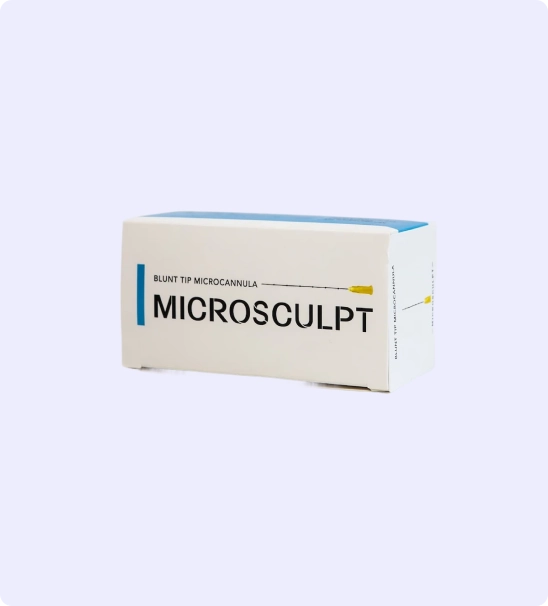
Injections Your Patients Will Love! Code “20OFF” Takes 20% off Your First Order!
Microcannulas are a tool that every great injector must master. Patients want quick results with no downtime. Our microcannulas are high quality and a fraction of the price of our competitors!
You can create an account here.
Two Considerations When Using a Blunt-Tipped Cannula
While a hypodermic needle and a blunt tip cannula share some similarities, proper cannula technique is very different from traditional needle handling. Because the cannula method relies on careful maneuvering of the blunt tip microcannula around the injection site, any cannula injection requires some adjustments from using a sharp-tipped needle:
1. Less force
The traditional needle is a rigid and flexible shaft that excels at penetrating the skin with the sharp tip and is particularly useful for procedures like an intravascular injection. However, a cannula injection can’t be applied with the same force, as it’s common for a blunt tip cannula to have a somewhat flexible shaft that can be moved beneath the surface of the skin.
This means the plastic surgeon or dermatologist should be careful about their injection technique when using a blunt microcannula since there’s the risk that the shaft could snap underneath the skin if too much force is applied. This is especially crucial if the injection site is near a major vein, blood vessel, or artery since any breaking in the shaft can potentially lead to vascular occlusion.
Another reason why a blunt microcannula requires less force is that a sharp tip needle pierces through the skin to get to the subdermal layers needed for dermal filler. However, the blunt tip of the microcannula pushes through the skin instead, which can nudge any vein or blood vessel out of the way without any major damage. One of the reasons why the cannula technique is preferred by many patients is that needle injection using a blunt microcannula is less likely to leave visible marks on the skin like bruising, and it also avoids other complications like occlusion.
2. Study of the filler treatment and its rheology
Understanding the rheology of different facial fillers is crucial to success with the cannula method. A hyaluronic acid filler like Restylane will have different rheology compared to a lip filler like Juvederm, and understanding these differences can give the patient the best possible results.
The microcannula technique makes using facial filler easier since the flexible tubing and the improved access to different injection sites make applying material easier to areas like the tear trough or the nasolabial fold. It can even improve cheek filler results as the flow rate of fillers is more easily controlled when using the cannula method compared to a sharp needle.
Keep in mind that while the cannula technique can be an excellent fit for most dermal fillers, an injector still needs to be careful about using a cannula without checking if it’s the best needle for the procedure. Certain facial fillers still work best with a hypodermic needle, and any attempt at using a microcannula with these procedures can be disastrous.
Why the Microcannula Technique Is Better for a Facial Filler Needle Injection
Aside from making the injector’s job easier, using a blunt tip microcannula also makes the procedure easier for the patient. There are two reasons why the microcannula technique is preferable over a hypodermic needle:
1. Less post-operative aftercare needed
One of the common drawbacks that a patient suffers from after the use of a traditional needle is the downtime required for their skin to recover from the effects of the procedure. While traditional sharp tip needles excel at penetrating the layers of the skin and tissue, they can often cause damage to the surrounding vein and blood vessels in the injection site. This can lead to the usual side effects associated with sharp tip needle use like bruising, bleeding, discoloration, and increased sensitivity.
A blunt tip microcannula avoids all this by having two design advantages over a sharp needle: the blunted tip and the flexible needle shaft. Both of these let the microcannula navigate around the skin with relative ease and little to no trauma to the surrounding tissue. While this does change the way the filler material needs to be distributed to more distant spots from the initial entry point, it significantly decreases the downtime required by the patient after the treatment is done.
2. Fewer entry points required
It’s not uncommon for a facial filler to be injected in different sites around the face, which means that using a sharp tip needle for it requires multiple entry points for more areas. Not only does this increase the risk of the patient developing an adverse reaction to so many injection sites on the skin, but this also means that the procedure may take longer to finish for the patient.
Using a blunt cannula prevents this by only requiring one initial incision for the needle to fit through. After it goes under the skin, it can be maneuvered as needed to different areas near the initial treatment site. This is particularly useful for filler products designed for the nasolabial fold since it’s possible to transition from using cheek filler to nasolabial filler without having to do another injection.
Get High-Quality and Affordable Medical Tools and Supplies From FACE Medical Supply Today
-
 Microcannula Multi-Gauge Precision Set
Microcannula Multi-Gauge Precision Set -
 Microcannula Complete Injection System
Microcannula Complete Injection System -
 Microcannula Size Progression Training Kit
Microcannula Size Progression Training Kit -
 Microcannula Professional Starter Kit
Microcannula Professional Starter Kit -
 Microcannula Volume Practice Pack
Microcannula Volume Practice Pack -
 23 gauge 50 mm (2 inch) Microcannulas
23 gauge 50 mm (2 inch) Microcannulas -
 22 Gauge 100 mm (4 inch) Microcannulas.
22 Gauge 100 mm (4 inch) Microcannulas. -
 27 Gauge 38 mm (1.5 inch) Microcannulas
27 Gauge 38 mm (1.5 inch) Microcannulas -
 25 Gauge 38 mm (1.5 inch) Microcannulas
25 Gauge 38 mm (1.5 inch) Microcannulas
While using a blunt cannula for dermal filler injection may seem challenging, the benefits that it offers over sharp needle use can greatly increase confidence in the results of the filler treatment, prevent a complication like an occlusion from occurring, and make future applications of facial injectables to the injection site much easier. It’s an excellent tool for any injector to use, with most patients reporting an easier time with facial filler treatments overall with blunt-tipped cannula application.
FACE Medical Supply is a proud partner of cosmetic practices and clinics across the country, providing them with high-quality medical tools and supplies from the blunt tip cannula to the traditional needle. We specialize in providing these goods at competitive prices and pride ourselves in combining product quality with excellent customer service.
For more information about us and our products, contact us today.
